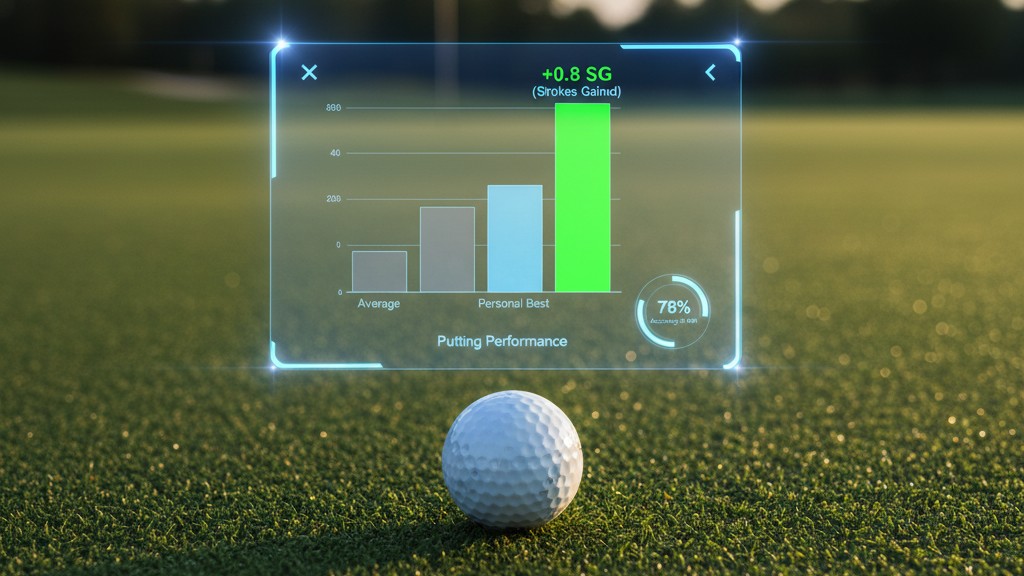
A Golfer’s Most Frustrating Moment
It’s happened to all of us. You’re standing on the 10th fairway, ready to attack the pin. You’ve hit a decent drive, and you’re feeling good. Then… THWACK. The ball shanks hard right into the trees. You take a drop, punch out, and two-putt for a frustrating double bogey.
That one bad shot sends a ripple of frustration through the rest of your round. You start overthinking your swing, trying to force shots you shouldn’t, and before you know it, that beautiful front nine is a distant memory. The common dilemma isn’t just the bad shot itself – it’s the emotional and strategic spiral that follows. You feel like you’re letting your emotions take over, but what if there was a better way? What if you could use objective data to make smarter decisions, even after a mistake?
What is Strokes Gained? A Simple Explanation
The concept of Strokes Gained was developed by Professor Mark Broadie of Columbia Business School. It’s a revolutionary way to measure golf performance, moving beyond traditional stats like “fairways hit” or “greens in regulation.” Instead, it answers a more critical question: How many strokes did you gain or lose relative to the average golfer on that shot?
Here’s the simple formula:
SG = Avg. strokes to hole out (start) − Avg. Strokes to hole out (end) − 1The values are the average number of strokes it takes to get the ball in the hole from a specific location on the course (e.g., 150 yards from the hole, 30 feet from the hole). The formula subtracts one to account for the stroke that was just taken. These averages were originally calculated using data from the PGA Tour’s ShotLink system.

Let’s break that down with an example:
- Shot: You hit a drive 300 yards down the middle.
- Average Pro Value: The average strokes to hole out from the tee box is about 4.0. The average strokes to hole out from where your ball landed (say, 50 yards from the hole) is about 2.5.
- Calculation: (4.0 – 2.5) – 1 = 0.5 Strokes Gained
In this scenario, you gained half a stroke on the average professional, meaning you were half a stroke better than what a pro would typically do on that shot. If your drive had gone into the rough, the ending value would have been higher (meaning it takes more strokes to get it in the hole from there), and you may have lost strokes.
The Four Pillars of Strokes Gained
Strokes Gained is most powerful when it’s broken down into its four key components. This allows you to pinpoint exactly where you’re gaining or losing the most strokes.
- Strokes Gained: Off the Tee This measures the strokes you gain or lose on all tee shots on par 4s and par 5s. A great drive sets you up for an easier approach, while a poor one puts you in a tough spot, costing you strokes.
- Strokes Gained: Approach This category tracks all full-swing shots from outside 30 yards. Are you a fantastic ball striker who consistently gives yourself short putts? Or are you leaving yourself in tough positions? This category will tell you.
- Strokes Gained: Around the Green This measures all shots from within 30 yards of the green, excluding putting. This includes chipping, pitching, and bunker shots. Being sharp around the green can save you from a lot of bogeys and doubles.
- Strokes Gained: Putting This is often the most revealing category for many golfers. It measures your performance on the green. Many golfers think they’re great putters, but a deep dive into the data often reveals where they are losing the most strokes—often from short range (inside 10 feet) or a poor long-range pace.
From Complex Stats to Simple Strategy

For a long time, sophisticated stats like Strokes Gained were reserved for elite tour pros with caddies and teams of analysts. It can be overwhelming for an amateur golfer to track all this data and make sense of it. In fact, many high-handicap golfers believe they only need to focus on simple metrics like Greens in Regulation (GIR) and putts per round.
While those simple stats are a great starting point, they don’t tell the whole story. You could hit a green in regulation and still be 50 feet from the hole, which is a poor shot. Strokes Gained provides the context that simple stats lack.
The problem for the average golfer isn’t getting the data – it’s understanding what to do with it. This is where Golf Course Intel come in.
The Golf Course Intel Advantage: Data as the Solution
Golf Course Intel is designed to be the definitive solution to the amateur’s dilemma by providing the tools to apply Strokes Gained principles to every round. Acting as a modern, data-driven caddie, it transforms subjective frustration into a clear, objective, and actionable plan.
Instead of guessing what’s wrong with your game, you can use the platform’s analytics to see precisely where you’re losing strokes. The platform can reveal, for instance, that approach shots from 100 to 125 yards are costing a golfer 1.5 strokes per round, while their driving accuracy is actually above average for their peer group. This kind of granular data eliminates the guesswork and allows golfers to practice with a purpose, focusing their time and energy on the most impactful areas of their game.
Your Personalized Strategy
The Golf Course Intel model turns your raw data into a personalized strategy. The following table illustrates the clear advantage of a Strokes Gained approach over traditional, more restrictive statistics, underscoring why an objective metric is essential for a golfer seeking meaningful improvement.
| Metric | Traditional Stat Insight | Strokes Gained Insight |
| Fairways Hit | A missed fairway is a missed fairway, regardless of whether it’s a yard off the line or out of bounds. | Distinguishes between a marginal miss that is still playable and a penalty shot, providing a truer measure of driving performance. |
| Greens in Regulation | A poor GIR percentage suggests a golfer’s iron play is weak, but doesn’t explain the cause. | Reveals if the poor GIR percentage is a result of weak approach shots or if the golfer never had a good look at the green in the first place due to a poor drive. |
| Putts Per Round | A low number of putts suggests a strong putting game, but can be misleading. | Pinpoints if putting is a true strength or a symptom of a weak short game that resulted in many short, easy putts. |

We take the same complex principles used by tour pros and make them simple and actionable for you. We transform your performance data into a personalized strategy guide that shows you, in clear, concise terms, exactly what to work on.
Instead of just telling you that you’re losing strokes around the green, we’ll tell you why – and what to do about it. Your strategy guide might recommend you focus on your short game, knowing that if you can improve those shots, your putting will take care of the rest.
Ready to Unlock Your True Potential?
Stop guessing and start improving. Don’t let a bad shot ruin your round or your confidence. Let your data guide you to a better game.
Request your Golf Course Intel strategy guide today and discover the exact areas you need to focus on to start gaining strokes and lowering your scores.




0 Comments